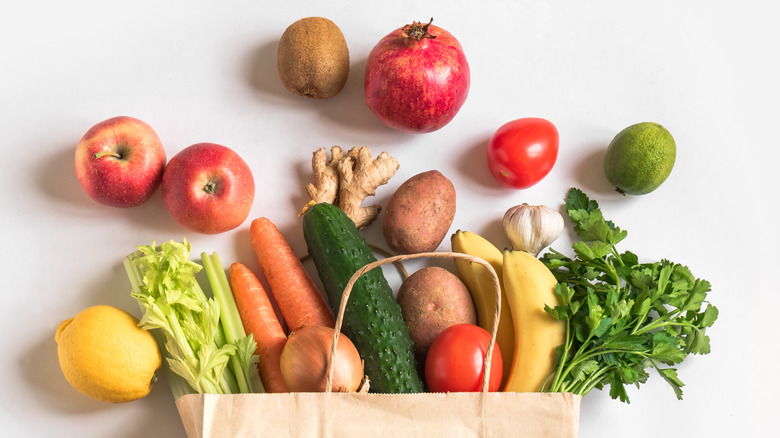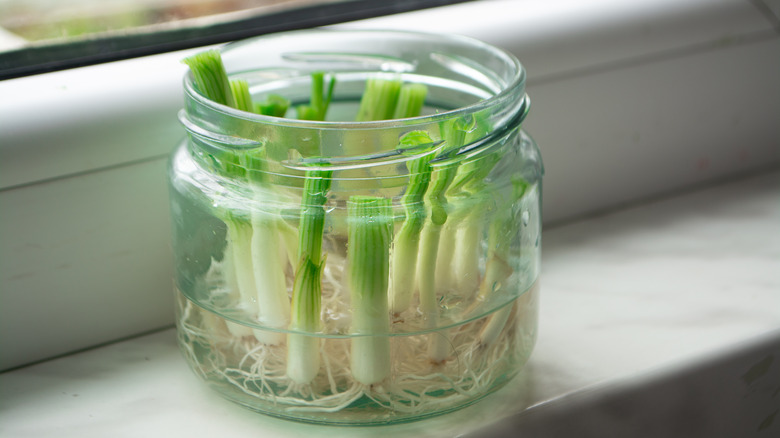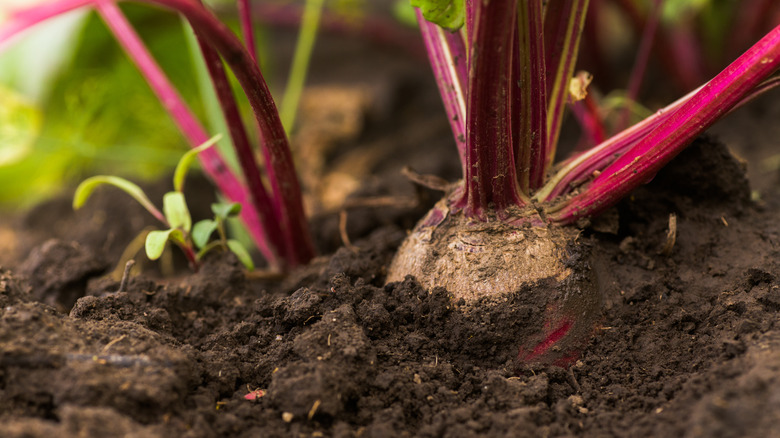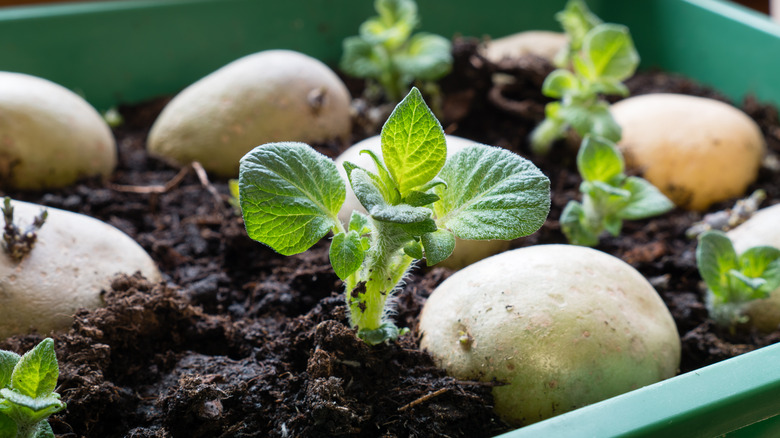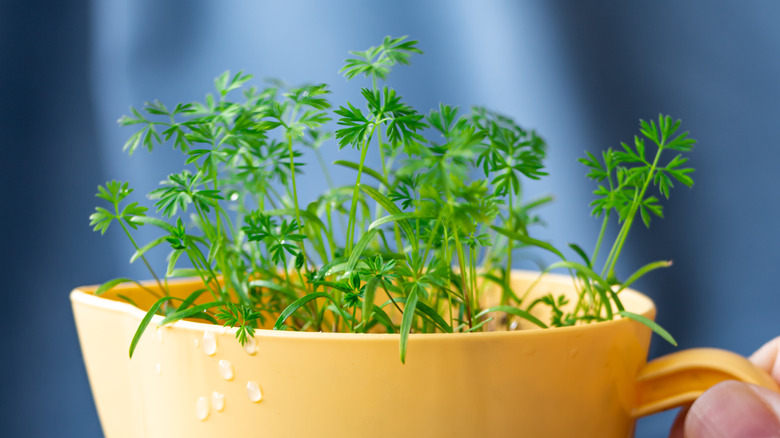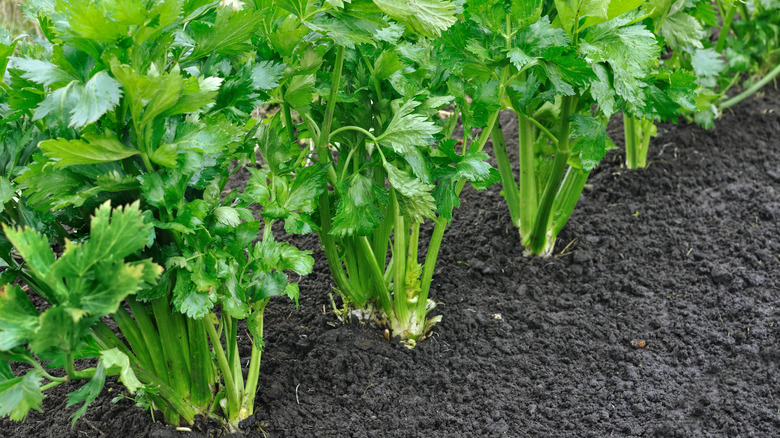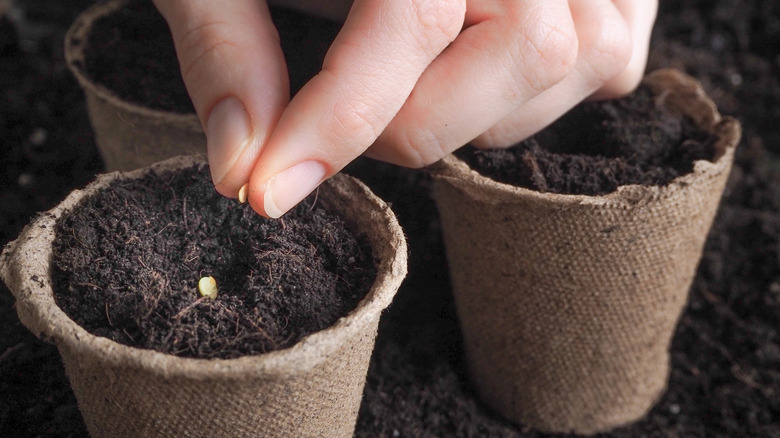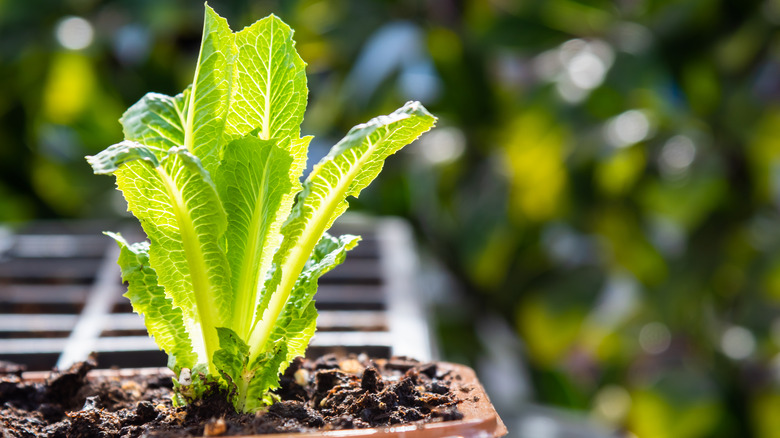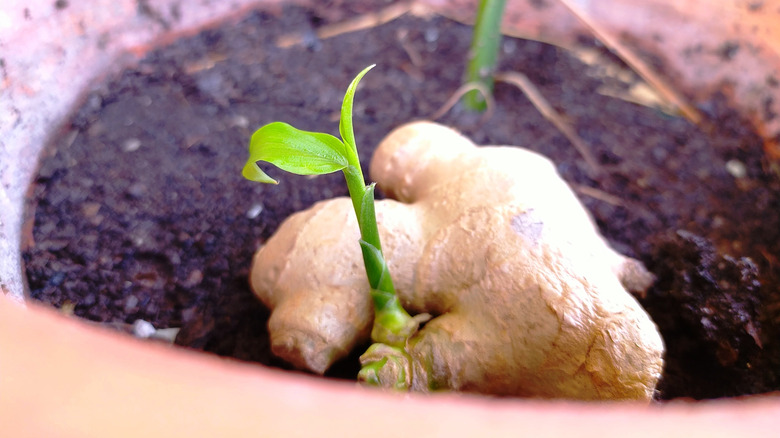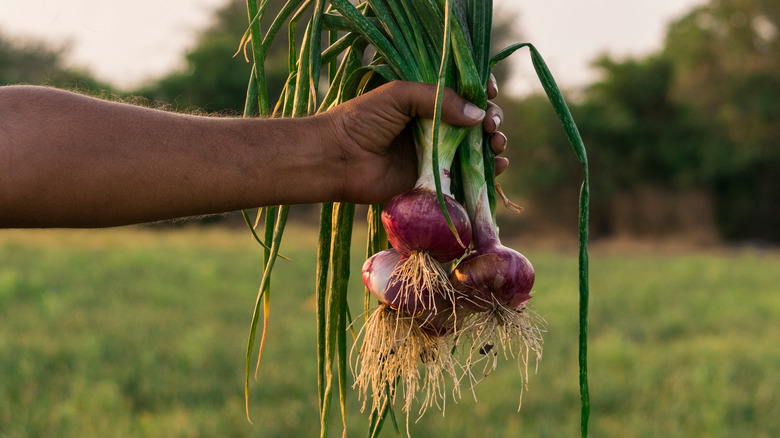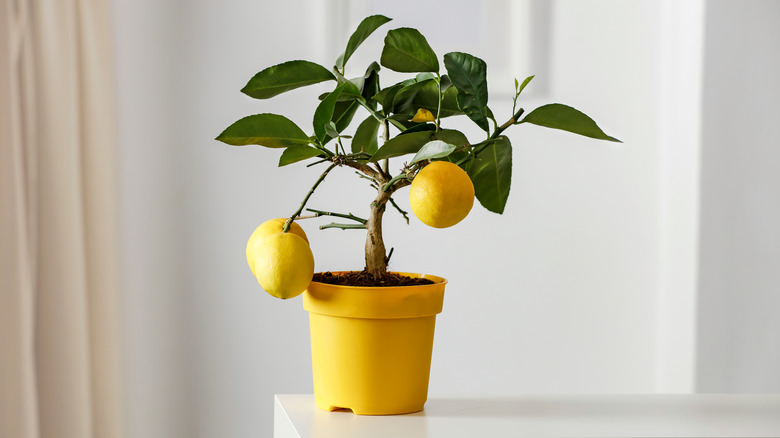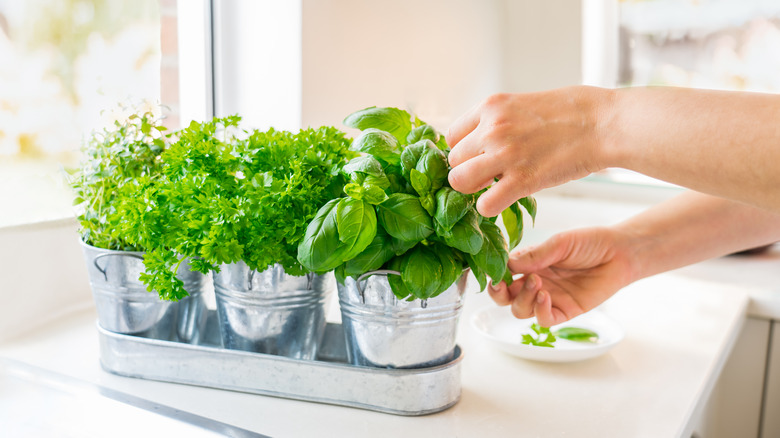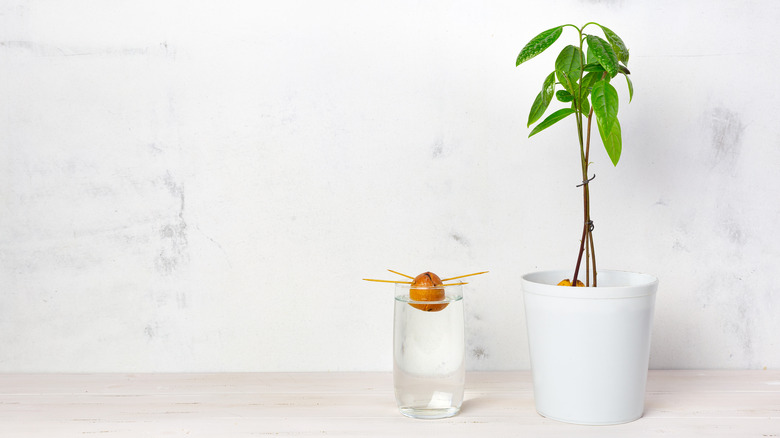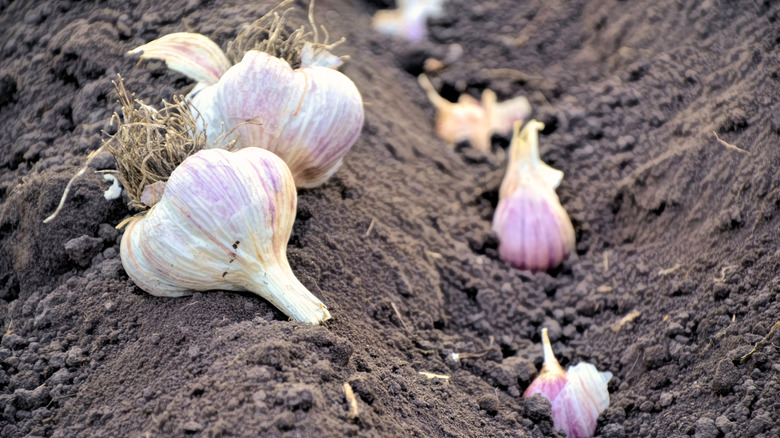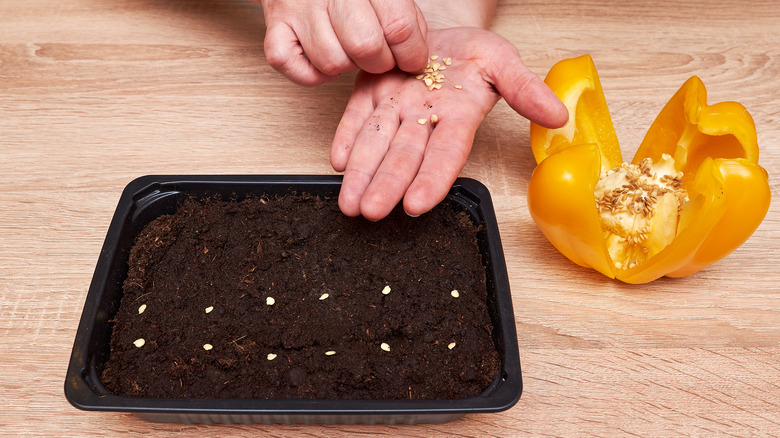The Best And Worst Produce To Regrow From Scraps
When it comes to sustainable eating, growing produce from scraps is one of the easiest and most cost-effective ways to produce less waste. As one article on Love Food Hate Waste shared, by lowering the amount of food wasted, people can help halt the progress of global warming. That's because global food waste is such an issue that if it were a country, "it would be third largest emitter of greenhouse gases after China and the US."
So what does growing vegetables or fruits from scraps mean exactly? Eating Well explained that it's the act of using "stems, butts and seeds from many common fruits and vegetables" and turning them "into a fresh new crop with soil, water, [and] sunlight." Some grow best while left alone, while others require basic indoor plant maintenance. And while it's an effective method for some produce, not every store-bought vegetable can be regrown from scraps.
Read on to find out what produce regrows best from scraps, which veggies and fruits need a little extra attention, and which ones might be best to avoid entirely.
Best: Spring onions will keep on growing
You might have noticed that spring onions are usually sold with their roots still intact, and according Allrecipes, "you can encourage those root ends to regrow new green onions." You'll just need spring onions, a jar, and water.
Start by chopping off the bulb end of your bunch of scallions, being careful to leave the roots in place, and stick the bulb, roots down, in a jar. Pour enough water into the jar so that the roots are covered, place the jar on a sunny windowsill, and change the water regularly –– about once a week, according to Allrecipes. Then, once the shoots are four or five inches long, you should pot your baby plants, adding soil, so that your new spring onions will continue to produce delicious shoots.
As you harvest your spring onions, note that you should cut all the way down to the bulb, or else you run the risk of an overgrown plant much larger than the bunches you can buy at the store!
Worst: You probably won't be able to grow beets
Urban agriculturist Bonnie L. Grant discussed the ins and outs of using beet scraps to grow a new plant in an article for Gardening Know How. While you can easily grow the leafy green tops found on beets, Grant said that with store-bought beet scraps, new bulbs are unlikely to form.
The good news is that beet leaves still serve a purpose and are edible. According to Grant, the greens are "similar to Swiss chard or other dark green leafy veggie tops," and can be added to a variety of dishes like stew. Grant advised buying organic beets and, for the purpose of regrowing their tops, to select beets that have "healthy greens and a solid, unblemished root." Once you're ready to propagate your beet leaves, place the beet top in a shallow dish of water. Keep the water fresh, and don't let it come up past the stemline.
"In just a week or so you will have new beet greens to cut," said Grant.
Best: It's not too hard to grow your own potatoes
If you've ever found an errant potato hidden away in the back of your crisper drawer, then you know that just leaving a potato alone can cause it to grow new roots. As this video posted by Martin Phan of Gardening Eats shows, those roots, or "eyes," can very easily be used to propagate and grow new potatoes.
Phan strategically removes each eye with a knife before noting that the final eye-free piece can be thrown away (or composted). Next, he adds a layer of soil to the bottom of a bucket and places each piece of potato into the soil, with the eye side facing up. He follows this with another layer of soil and uses his metal hand shovel to further break up the potato pieces before adding water.
As the plant grows, Phan advises adding more soil to cover the potatoes. Eventually, each potato plant could yield anywhere from four to six potatoes!
Worst: Don't expect to harvest carrots from scraps
According to a step-by-step guide on Instructables, discarded carrot tops can be used to regrow mini plants. But, similar to beets, the end result is not more carrots –– it's a tiny plant that flowers, also known as a carrot bonsai. If you're not interested in growing more carrots from your scraps but are looking for a mini pop of green to add to your windowsill or a sunny spot, then this might be worth a shot. All that's needed is leftover carrot tops, water, a shallow dish, and a small, sunlit space or window ledge.
For this regrowth project, you'll need carrot tops. Those that maintain about an inch of the stems and leaves will yield the best results. Simply place these ends into a small amount of water in a shallow dish, and set the dish in a sunny spot. Miniature green shoots will sprout and grow, as long as you're diligent about changing the water each day. Otherwise, the carrots will begin to rot.
Best: Growing celery from scraps is pretty simple
Much like spring onions, celery is also extremely easy to regrow from scraps, as long as you choose a head of celery with the roots still in tact. Allrecipes provided step-by-step instructions on how to turn your store-bought stalks into a new plant of your very own. According to the article, step one is to cut two inches "off the root end of a bunch of celery." Step two is to place it in a shallow dish, bowl, or jar, with the roots side down ... and then that's pretty much it! Then, once you place your celery in a well-lit spot, making sure to change the water often, your next job is to watch it grow.
Once the roots are about an inch long, you can then repot your new celery plant in potting soil or simply add it to an existing garden. The stalks should grow lush and green and ready for chomping down on.
Worst: Growing tomatoes from scraps is not for the newbie gardener
While you can grow tomatoes from scraps, Ready to DIY warns that it depends on a multitude of variables. The "variety you pick and environment conditions are essential factors," according to the article. Apparently, the best option is organic heirloom tomatoes because other options run the risk of producing "plants and fruits different in taste and look from the tomatoes you bought." This is especially true if you plant the seeds of a hybrid tomato plant.
Growing tomatoes from the seeds of store-bought tomatoes also requires a few more steps than just harvesting your seeds, planting them in soil, and watering them until they grow. Instead, Ready to DIY suggests fermenting the seeds first, which "can be a lengthy and smelly task." Once they're properly fermented, wash the seeds, plant them in soil, and, eventually, move them into bigger containers as they germinate. If this all leads to success, your new tomato plants can be transplanted outdoors.
Best: You can grow lettuce from scraps ... to a point
According to food blogger Getty Stewart, romaine lettuce is another head-form veggie that grows well from scraps. Though almost any lettuce or cabbage with its stem-end still intact will work, romaine seems to yield the best results.
However, before you start dreaming of an endless supply of romaine, Stewart pointed out that "you won't be able to regrow a full head of lettuce." Using this method, you can only expect a few leaves, around two to four inches long. "Enough for a sandwich," said Stewart. Much like the methods above, Stewart advises setting your remaining lettuce stem in a shallow bowl of water and placing the dish on a bright windowsill. Just be sure to swap out the water every one or two days.
Ten to 12 days later, you'll have leaves of lettuce, perfect for a small dish. But be warned: if you let your lettuce grow past a certain point, "it will become spindly and bitter as it attempts to produce seed." And if that happens, you won't want to eat it.
Worst: Growing ginger is a lengthy process
According to Reader's Digest, growing ginger from scraps is possible, but it also requires more perseverance than other herbs and vegetables. It also only really works with ginger that's already sprouting green buds. The publication recommends washing the root before placing it in a pot with gritty compost. Once the ginger is planted, place your pot in a sunny spot or on a windowsill. After a few weeks, you should see green shoots sprouting from the ginger, but it takes about six to eight months to grow a new, useable ginger root.
After enough time has passed, you'll know that your ginger is ready to harvest once the foliage on the plant dies. If you've reached that point, then it could be time to pull your ginger ... or you could wait even longer until the ginger root –- called a rhizome –– is even larger.
Best: Why not try to grow white, yellow, and Vidalia onions?
Much like spring onions, other kinds of onions regrow easily from scraps, including white, yellow, and Vidalia onions. Best of all, once your onions sprout, these new offshoots can be separated into multiple plants, according to home and garden blogger Carol Speake at The Gardening Cook.
To regrow an onion from scraps, you'll need to use the bottom. This is the piece that holds the roots, and it should be removed from the rest of the onion with a knife. Next, let your removed onion bottom dry out for a few days before sticking the bottom with toothpicks. Now, placing the toothpicks on the edge of a glass, suspend the onion bottom over water, so that the part with the roots is submerged. Within four days to a week, roots will sprout and grow, and the bottom can be replanted in soil. Keep the potted onion well-lit and the soil "moist," and you'll eventually have a new onion plant that can be divided into multiple onion plants!
Worst: You might be able to grow lemons ... if you have 15 years to devote to it
Store-bought lemons can technically be used to cultivate a new citrus tree, but according to SFGate, it can take anywhere from 5 to 15 years for your tree to produce fruit. Plus, "fruit from seed-grown lemon trees may not always be true to the fruit the seed came from," warned the publication.
If you're sure you want to give growing a lemon tree from seeds a try, then note that your seeds should first be rinsed thoroughly before planting. This is to avoid planting your seeds with any remaining sugar. According to SFGate, sugar "can trigger fungi, which can kill the seedlings."
Once planted, as your seed grows into a tree, consider the temperamental nature of citrus trees. Lemon trees are sensitive to extreme temperatures, so if you live in a colder climate, be sure to bring your tree in somewhere warm for the winter months.
Best: Herbs might take a while to grow, but are easy to manage
According to Gardening Know How, certain herbs can be propagated from stem cuttings. All you need is to snip off about four inches of your herb of choice's stem, leaving the top few leaves in place. Remove the lower leaves, and place your stem in a glass of water. There should be enough water to cover the areas where the lower leaves were before you removed them.
With the upper leaves above the waterline, place the container in a bright or sunlit spot, and change the water every few days. Unlike most of the other vegetables that grow from scraps, herbs can take a few weeks to grow roots. Once they've sprouted and are about an inch long, you can plant your herbs in soil. This method works great for leafy herbs like thyme, basil, rosemary, and mint, which is a particularly easy plant to maintain.
Worst: Avocados are a tricky fruit to grow from scraps
Avocado trees take years to bear fruit (if they do at all), but Reader's Digest shares how the discarded pit of an avocado can "yield you an attractive looking house plant."
Once you've extracted the pit –– also called a stone –– you'll need to wash it thoroughly before peeling away the dark outer skin to get to the pale inner skin. With the pointier end of the pit facing upward, insert three or four toothpicks into its sides. These should be positioned around the middle of the pit and "evenly spaced." Once your toothpicks are inserted, set the pit on top of a container of water, so that the bottom is covered. Change the water daily, and once the seed splits and roots appear, a stem will begin to grow.
When the stem is about eight inches tall, remove the toothpicks and plant your new little tree into a well-drained pot.
Best: You can plant garlic scraps right in your garden
According to Gardenisms, garlic can easily be regrown from either a clove, or from the discarded bulb. You can even plant your garlic indoors or outside.
Use well-draining soil away from other allium crops, like onion, leek, shallots, scallions, or chives. Gardenisms suggests planting your cloves in a sunny spot when the weather is warm. Spring is best in the northern U.S., while fall is fine for southern states. As you plan your garden, you'll want to plant the cloves about six inches apart and in rows 12 inches apart if you're planting a lot. Place the pointed end of the clove facing up and the flat end positioned into the soil, or bury the bulb roots with soil.
Push your cloves so that they're around two inches into the soil. Water regularly, and you'll know that your garlic is "ready to harvest when the leaves have dried and turned brown or fallen off the plant."
Worst: While not impossible, peppers are pretty darn difficult to grow
PennLive garden writer George Weigel explained that peppers can be grown from store-bought peppers, but with very specific conditions and requirements that might be impossible to know before you cultivate the seeds.
The first consideration is whether or not the peppers were picked "green before the seeds matured enough." According to Weigel, "If the fruits you bought were red, orange, yellow or other ripe color, you've probably got mature seeds." Additionally, you probably won't grow the same kind of peppers you purchased from the store if those peppers are hybrids. And this is if peppers grow at all, as hybrid peppers can be "sterile."
However, if you are able to get the seeds to germinate and grow, then Weigel suggests starting the seeds inside and transporting them outside after mid-May. Assuming this all works, then you could be picking peppers by mid-summer.
